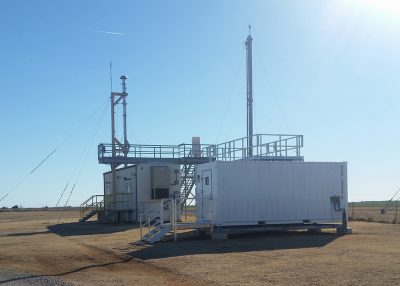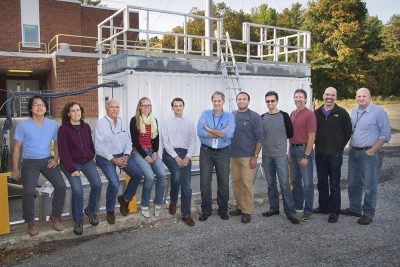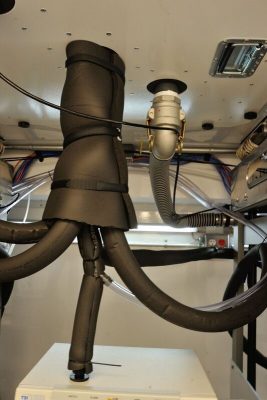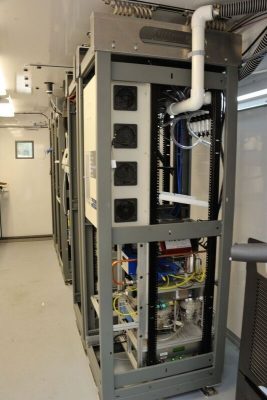New Aerosol Observing System Deployed to Southern Great Plains
Published: 20 February 2017
Next-generation Aerosol Observing System up and running 24/7 since November

In November of last year, a brand-new Aerosol Observing System (AOS) was trucked from Long Island, New York, to the Southern Great Plains (SGP) atmospheric observatory in Oklahoma. It’s been live and working 24/7 ever since, side by side with the first AOS, deployed in 1998, which it will soon replace after intercomparison tests. Yet, this change means more than simple replacement of the original unit, which has served for nearly 20-years: The new AOS represents an upgrade for observational capability at the SGP.
Who You Gonna Call?
Brookhaven National Laboratory (BNL), that’s who, if you want a custom-designed-and-built, cutting-edge, fully instrumented, mobile, plug-and-play, remote-controlled, aerosol research laboratory that can operate anywhere in the world in any conditions, from the frigid Arctic to the steamy Tropics. They’ve done it before, and they’ve just done it again: each time, they just get better at nailing the assignment.

Scott Smith, a project engineer in BNL’s Environmental & Climate Sciences Department, leads the AOS design team that has specified, built, and field-tested two of these sophisticated atmospheric measurement systems for the ARM Facility in just the last year. The first was given its shakedown cruise at the SGP megasite in Oklahoma before deployment on the North Slope of Alaska (NSA) at Oliktok Point, where it’s now a key component of the third ARM Mobile Facility. The second is now humming away, pumping out data at the SGP.
It’s All About Bang for Buck
So the AOS concept has come full circle, evolving through six iterations, each adding more or different instruments, newer technology, smarter layout, and enhanced usability, both for the operators on the ground and the instrument mentors and engineers like Smith who monitor their instruments remotely from BNL, Argonne National Laboratory, or other labs.
Atmospheric scientists, of course, have played a key role in ongoing AOS development. Ernie Lewis, a BNL aerosol expert in Smith’s department, worked closely with the team to improve the design of the last two AOSs and tailor them to the needs and cost parameters of their particular locations. Because an AOS represents a significant capital investment, it’s important to get it right.
“This is basically a lab you can ship anywhere,” says Lewis. “It’s fully operational in less than four hours; all you need is power—plus internet for remote access. Each time Scott’s team designs a new AOS, we try to incorporate changes based on experience that will help the operators in the field.”
In this case, Mike Ritsche, Assistant Site Manager at SGP, provided crucial design input—things his team wanted changed from the SGP’s first AOS. Ritsche works at Argonne National Laboratory, which manages the SGP observatory.
What’s in the Box?
The new AOS for the SGP differs from its NSA predecessor in several ways. First, the new one was ordered with many basic design features already built in, whereas the previous one was an off-the-shelf steel shipping container that had to be modified by BNL for every requirement. That saved time in fabrication, all of which was done by engineer Smith, lead technician Gabe Vignato, and a couple of instrument mentors helping part time. From go to whoa, they needed just four months to roll their latest finished product off the BNL assembly line.

Second, the “stack”, a 20-foot-tall pipe on top of the container used to pull in sample air, was moved from the end to the middle, which equalizes the strain on the eight corner-mounted guy wires and eliminates wind loading issues. The downside, though, was that this change complicated the plumbing, which now runs in both directions from the central stack to instruments inside the container that are mounted on both sides of it.
Third, the new unit has a larger instrument suite, so it can make more measurements. Lastly, the SGP AOS has uninterrupted power supply (UPS) backup on all instruments, not just critical ones, so intermittent power outages or surges will not affect measurement continuity, which is crucial to recording an unbroken—and therefore far more valuable—data set.
Doing More, with More
Scott Smith has a lot of experience under his belt working on climate research field campaigns for both the ARM Facility and the National Oceanic and Atmospheric Administration (NOAA). On ARM’s Green Ocean Amazon 2014/15 campaign, for example, he helped prep the remote aerosol sampling labs deployed in the Brazilian rainforest. This invaluable experience helped in designing the new AOS, which measures the composition, size distribution, and ability to scatter and absorb light of both anthropogenic (manmade) and naturally produced (including biogenic, or those produced by vegetation) aerosol particles. These detailed data are essential to understanding more about the formation and behavior of clouds, a key driver, though still poorly understood, of regional and global climate regimes.

The new AOS has over a dozen instruments mounted in shock-isolated racks to stop vibration in transit (think potholes) and operation (think earthquakes) from disrupting operation. Besides the UPS to even out power supply, the latest AOS also boasts power distribution units (PDUs) that enable remote control. Further, it has a networking system that allows the instruments to talk to each other, and for their remote minders to reallocate power if necessary. Finally, like its predecessor, the new AOS houses all of its pumps, along with a dryer to produce reagent air at less than 10 percent relative humidity, in a dedicated cabinet on an umbilical, deployable in or outside the container, which has pull-out racks to improve maintenance access.
The Data Must—and Does—Go Through
During fabrication of the new AOS, up to four people worked inside at once, modifying the 8’ X 8’ X 20’ box and installing gear. Completed and deployed, the new AOS remains comfortable for two operators.
Smith explains, “Once a day, an operator checks all the instruments. It takes 30 to 45 minutes using a checklist. But because of the remote control feature, I can also check instrument performance at any time; so can the mentors–we do it every day. I also check the pumps and driers, right from my office at BNL. If we see anything odd, we call site operations to take a closer look: there’s still nothing like boots on the ground. A third level of inspection by the ARM Data Quality Office applies computer checks and visual inspection of all data for issues. This redundant oversight means we can respond to anomalies before they become problems, and—usually—that means no break in the datastreams. That’s what we aim for.”
With the mechanical cam locks holding the container to its steel support frame locked, data flowing out ceaselessly, and minders near and far hovering over instrument performance, the new AOS is off to a good start at the honorable SGP site.
# # #
The ARM Climate Research Facility is a national scientific user facility funded through the U.S. Department of Energy’s Office of Science. The ARM Facility is operated by nine Department of Energy national laboratories, including Brookhaven National Laboratory and Argonne National Laboratory.
The ARM Climate Research Facility is a DOE Office of Science user facility. The ARM Facility is operated by nine DOE national laboratories, including .
Keep up with the Atmospheric Observer
Updates on ARM news, events, and opportunities delivered to your inbox
ARM User Profile
ARM welcomes users from all institutions and nations. A free ARM user account is needed to access ARM data.


















